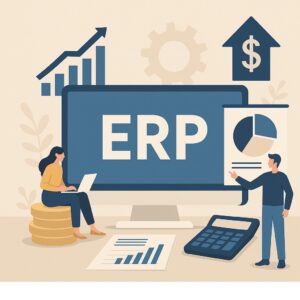Tech News
How to Make Sense of ERP Investment and ROI in a Growing Company
As a business grows, so do its challenges. Scaling operations means managing more data, coordinating more teams, streamlining workflows, and maintaining control over finances and inventory. To tackle this complexity, many companies consider investing in an Enterprise Resource Planning (ERP) system. However, ERP solutions—especially comprehensive platforms like NetSuite—can carry a significant upfront cost, making some leaders hesitant. So how do you evaluate whether ERP is worth the investment? And more importantly, how can you measure its return on investment (ROI)?

This guide helps demystify ERP investment for growing companies and shows how to assess its true value—not just in dollars, but in long-term operational impact.
What Is ERP, and Why Do Growing Companies Need It?
ERP systems unify core business processes into a single platform, giving organizations better visibility and control over departments such as finance, inventory, HR, sales, procurement, and customer relationship management. Instead of relying on disconnected spreadsheets, emails, and software tools, ERP consolidates data into one central source of truth.
For a growing company, this can be transformative. Expansion usually introduces layers of complexity: increased sales channels, multi-location inventory, vendor management, compliance requirements, and more. Without a structured system, these processes become bottlenecks and sources of error. ERP not only helps avoid those pitfalls but also provides scalable infrastructure for future growth.
The Initial Investment: What Are You Paying For?
The cost of ERP implementation varies widely depending on company size, industry, and scope of customization. Typically, expenses include:
- Software licensing or subscription fees
- Implementation and configuration
- Training and change management
- Ongoing maintenance and support
Cloud-based solutions like NetSuite tend to charge a monthly or annual subscription fee, which includes software updates, data backups, and tech support. On-premise ERPs may have higher upfront hardware and licensing costs but lower ongoing subscription costs.
Then there’s the time factor. ERP deployment can take weeks or even months, depending on how many modules you need and how ready your data is for migration. This time commitment represents a hidden cost—especially if internal teams are pulled from daily operations to support the transition.
Calculating ROI: A Practical Framework
To determine whether ERP is worth the investment, you need to calculate potential ROI. That requires identifying both tangible and intangible benefits.
Tangible ROI Metrics
- Time Savings: Automating manual processes (e.g., invoicing, payroll, reporting) can significantly reduce employee hours spent on routine tasks.
- Error Reduction: Manual data entry mistakes can cost businesses thousands. ERP systems minimize this risk by integrating data flows across departments.
- Inventory Optimization: Better inventory visibility helps reduce overstocking and stockouts, cutting carrying costs and improving customer satisfaction.
- Improved Cash Flow: Streamlined billing and receivables processes speed up payments and reduce days sales outstanding (DSO).
Intangible ROI Factors
- Decision-Making Agility: Real-time reporting lets leadership respond quickly to market changes.
- Scalability: As you grow, ERP systems adapt—adding new users, functions, and geographies with less friction.
- Compliance Confidence: Built-in audit trails and reporting features simplify tax filings, regulatory submissions, and investor reporting.
To quantify ROI, many businesses use a formula:
ROI (%) = [(Net Benefits – Total Costs) / Total Costs] x 100
Net benefits include cost savings and revenue enhancements derived from ERP over a specific period, usually 12 to 36 months. While it’s not always easy to assign dollar values to intangible gains, ignoring them can lead to underestimating ERP’s true impact.
Common Pitfalls in ERP Evaluation
Before committing to a platform, be aware of these common mistakes:
- Focusing solely on cost: Choosing the cheapest option often leads to poor scalability and higher long-term costs.
- Underestimating training needs: A powerful system is only effective if your staff knows how to use it.
- Overlooking post-implementation support: ERP isn’t a “set-it-and-forget-it” solution. Updates, integrations, and user support are ongoing needs.
It’s also essential to choose a system that aligns with your industry-specific requirements. A manufacturing firm’s ERP needs will differ from those of a professional services business or an eCommerce company.
Understanding NetSuite and ERP Subscription Models
Cloud-based ERP platforms like NetSuite offer flexibility for growing businesses. NetSuite’s modular structure means you only pay for what you need—finance, inventory, CRM, etc.—and you can add more as your company evolves.
One of the biggest questions for potential users is: how much will it cost? Pricing depends on the number of users, required modules, and implementation complexity. For those looking to explore this further, an excellent resource that breaks down netsuite pricing can help you make an informed decision based on your company’s size and goals.
Making the Case to Stakeholders
If you’re not the sole decision-maker, you’ll likely need to convince others on your team. Here’s how to build a persuasive case:
- Start with the pain points: Outline where current systems fall short and how that impacts efficiency, revenue, and morale.
- Show cost-benefit comparisons: Estimate what inefficiencies are costing you now versus the long-term savings and gains an ERP system can deliver.
- Present projections: Model best-case, average, and worst-case ROI outcomes. This shows you’ve thought through the risks and upside.
- Highlight industry benchmarks: Share how similar companies are using ERP to grow or streamline operations.
Post-Implementation: How to Track ROI Over Time
Once ERP is live, it’s crucial to track performance metrics to ensure ROI is being realized. Common KPIs include:
- Days to close monthly financials
- Order fulfillment accuracy
- Inventory turnover
- Invoice processing time
- Customer satisfaction scores
Regularly reviewing these metrics helps identify further areas of optimization. Some companies find the real ROI continues to grow as they fully leverage advanced modules like business intelligence, predictive analytics, and automated compliance reporting.
Final Thoughts
Investing in an ERP system is a significant step for any growing company. It requires time, money, and careful planning. But when implemented strategically, it’s one of the most powerful tools for scaling with confidence and clarity.
ERP isn’t just a software expense—it’s a business transformation engine. The key is approaching the decision with a clear understanding of both costs and benefits. With the right setup, partner support, and training, your ERP investment can pay dividends far beyond its initial price tag.
Whether you’re still comparing vendors or trying to understand the long-term impact, take your time. ERP isn’t a one-size-fits-all solution, but when chosen and deployed well, it becomes the backbone of a more agile, efficient, and profitable organization.





